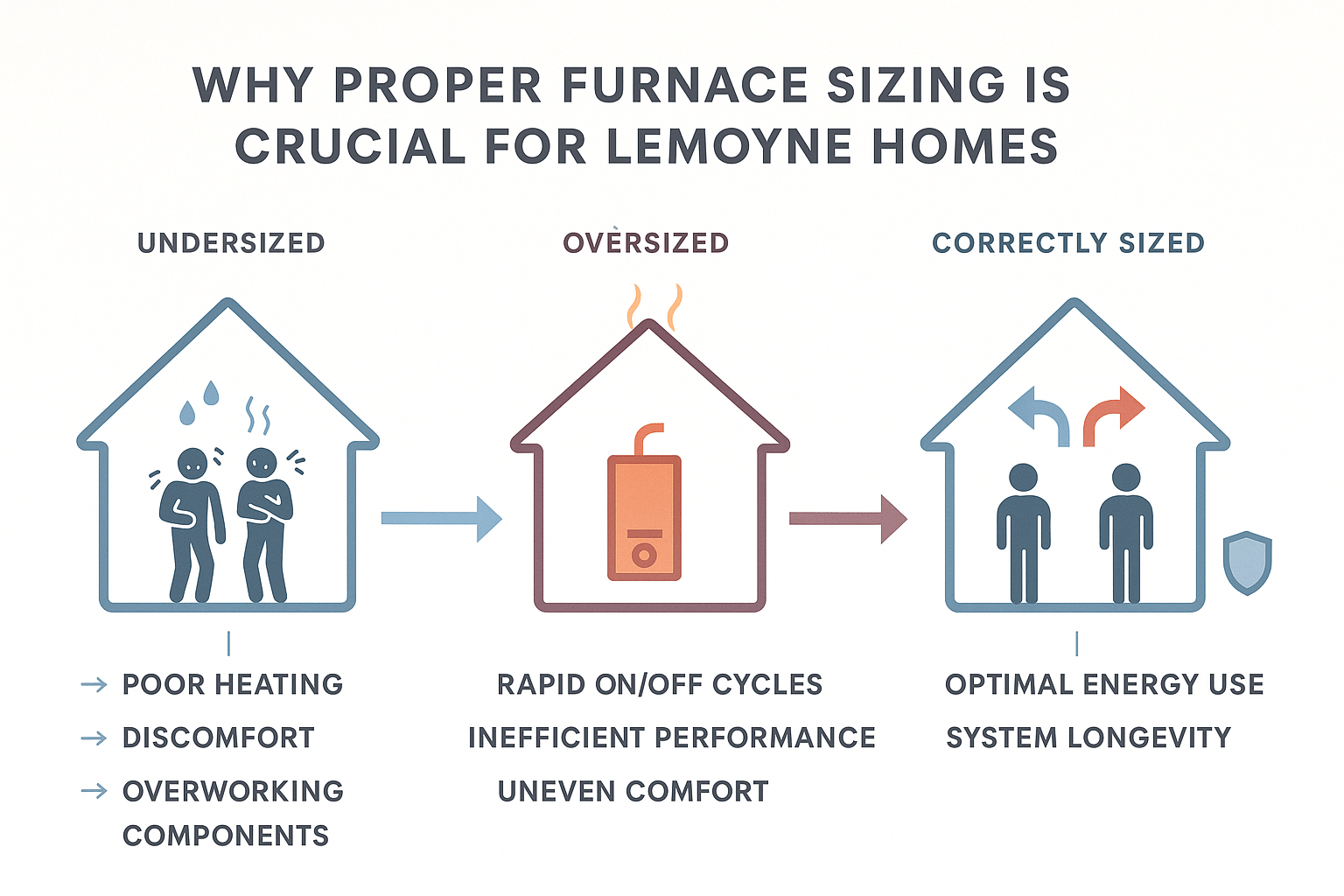Choosing the right furnace size is essential for maintaining your home’s comfort and efficiency. Many homeowners make furnace sizing mistakes by selecting units that are too large or too small, often during a new furnace installation in nearby York, PA . That leads to uneven heating, higher energy bills, and unnecessary wear and tear. Understanding the most frequent errors helps you avoid those pitfalls and ensures your system operates more reliably.
Why Proper Furnace Sizing Matters
Homeowners want consistent warmth during the colder months. When a furnace is incorrectly sized, the result is often uneven heating, uncomfortable drafts, and higher operating costs. These issues not only reduce comfort but also shorten the lifespan of the system.
Getting the sizing right from the start helps create steady comfort, keeps bills manageable, and prevents premature system failures. Proper sizing is more than a technical step; it is the basis for dependable heating performance.

Comfort and Efficiency Impacts of an Incorrect Furnace
Selecting the right furnace size is one of the most important decisions homeowners can make when it comes to indoor comfort. An incorrect size, whether too large or too small, creates challenges that affect daily living, long-term efficiency, and system health. Many people assume that a bigger unit will provide faster heating or that a smaller one will save energy, but both assumptions are incorrect. Instead, improper sizing disrupts the system’s ability to operate smoothly. The result is a home that feels less comfortable, energy bills that climb higher, and equipment that wears out sooner than expected.
The effects of incorrect sizing are wide-ranging:
-
Oversized furnaces heat too quickly and shut down in short cycles. This increases wear on components and creates uneven temperatures throughout the home.
-
Undersized furnaces run constantly but often fail to maintain warmth. This raises utility bills while still leaving rooms underheated.
-
Incorrect sizing can also affect indoor air quality by impacting humidity control and airflow balance.
Correct sizing ensures the system operates as intended, providing reliable comfort while avoiding wasted energy. It also means homeowners can expect steadier performance with fewer repairs over time. By working with a professional who calculates furnace capacity based on insulation, layout, and climate, you prevent the common pitfalls of short cycling, poor airflow, and rising utility costs. Ultimately, proper sizing helps your furnace last longer, keeps your household more comfortable, and preserves the efficiency that saves money month after month.
Understanding HVAC Tonnage and BTU Rating During Furnace Installation
When choosing a furnace, two technical details often confuse homeowners: tonnage and BTU rating. These measurements determine the system’s capacity to heat a home effectively. Tonnage refers to the amount of heat a furnace can move, while BTU (British Thermal Unit) rating measures the energy needed to heat a specific volume of air. If either is miscalculated, the result is a system that struggles to provide consistent warmth or wastes energy by overproducing heat.
Accurate calculations require more than a rough estimate. Square footage plays a role, but insulation levels, window placement, ceiling height, and even the orientation of the home to the sun must also be considered. Local climate conditions further influence the demands placed on the system. By understanding these factors, a properly selected furnace ensures balanced performance, reduced energy costs, and dependable operation season after season without the common frustrations caused by incorrect sizing.
How Accurate Sizing Improves Reliability and Reduces Energy Costs
When a furnace is sized accurately, the benefits are clear:
-
Steadier indoor temperatures
A properly sized system heats rooms evenly without the hot-and-cold spots that come from short cycling or overworked equipment. This creates a more comfortable living environment throughout the home. -
Lower energy bills
With the right size, the furnace runs only as much as necessary, avoiding wasted fuel or electricity. This efficiency translates directly into long-term savings on utility costs. -
Reduced strain on mechanical parts
Systems that are too large or too small often cycle incorrectly or run continuously, wearing out components. Proper sizing helps preserve the furnace’s internal parts, extending its service life. -
Fewer repair needs over the system’s lifespan
Because the furnace operates as intended, it experiences less stress and requires fewer service calls. This reliability provides peace of mind and reduces the likelihood of unexpected breakdowns during peak heating seasons.
Accurate sizing is about more than comfort on a cold night. It supports the health of the furnace, keeps energy consumption under control, and ensures the system remains dependable year after year. This holds true no matter if gas or electric . By focusing on precision during installation, homeowners gain both immediate benefits and long-term value from their investment in heating equipment.
Common Mistakes in Ductwork Design Affecting Furnace Performance
Even with the right furnace size, ductwork design can determine how well the system functions. Common problems include:
-
Undersized ducts that restrict airflow and overwork the furnace
-
Oversized ducts that reduce pressure and responsiveness
-
Leaky ducts that waste heated air into unconditioned spaces
-
Poorly insulated ducts that allow heat loss before reaching living areas
A furnace and ductwork must be considered together. Well-planned ductwork ensures heated air is distributed evenly and efficiently throughout the home.
Preparing for Reliable Warmth
A properly sized furnace makes a lasting difference in comfort, efficiency, and reliability. If you suspect your current system may not be the right size, or you are considering a new installation, it may be worthwhile to schedule an assessment with a trusted heating professional. Taking this step ensures your system is matched to your home’s needs and keeps you comfortable through Pennsylvania’s coldest months.


